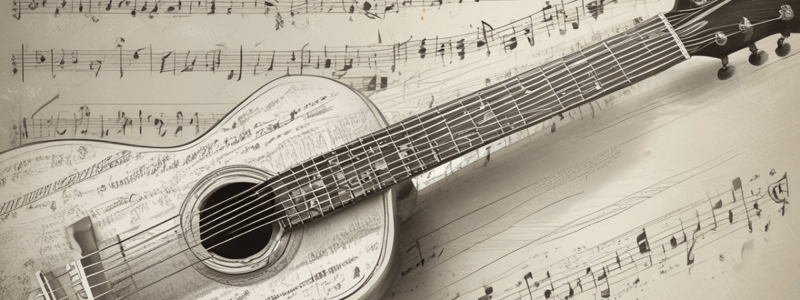Podcast
Questions and Answers
What is the main purpose of tablature notation?
What is the main purpose of tablature notation?
- To provide a graphical representation of which frets to press and which strings to pluck or strum (correct)
- To represent musical notes on a staff
- To notate drumming techniques
- To indicate the tempo of a song
What does each line in a tablature notation represent?
What does each line in a tablature notation represent?
- A different tempo
- A different musical note
- A different string of the instrument (correct)
- A different technique
What does the number '3' on the high E string indicate in a tablature notation?
What does the number '3' on the high E string indicate in a tablature notation?
- To press down the third fret on that string (correct)
- To strum the entire guitar
- To play the third note of a chord
- To pluck the third string
What is the purpose of the 'h' symbol in tablature notation?
What is the purpose of the 'h' symbol in tablature notation?
What is the purpose of the 'p' symbol in tablature notation?
What is the purpose of the 'p' symbol in tablature notation?
What type of instruments is tablature notation commonly used for?
What type of instruments is tablature notation commonly used for?
What does a tablature notation provide compared to traditional sheet music notation?
What does a tablature notation provide compared to traditional sheet music notation?
What is the main difference between tablature notation and traditional sheet music notation?
What is the main difference between tablature notation and traditional sheet music notation?
What does the symbol 'b' typically indicate in tablature notation?
What does the symbol 'b' typically indicate in tablature notation?
What is the purpose of the symbols '/r' and 'b' in tablature notation?
What is the purpose of the symbols '/r' and 'b' in tablature notation?
What is an advantage of using tablature notation?
What is an advantage of using tablature notation?
What is essential to understand when starting to use tablature notation?
What is essential to understand when starting to use tablature notation?
What is the function of the numbers on the lines in tablature notation?
What is the function of the numbers on the lines in tablature notation?
What is a limitation of tablature notation?
What is a limitation of tablature notation?
What is the symbol 'r' typically used to indicate in tablature notation?
What is the symbol 'r' typically used to indicate in tablature notation?
What is the best way to determine the rhythm and timing of a song when using tablature notation?
What is the best way to determine the rhythm and timing of a song when using tablature notation?
Study Notes
Introduction to Tablature
- Tablature notation is a widely used form of musical notation, especially for stringed instruments like guitar, bass, and ukulele.
Understanding Tablature Notation
- Tablature notation visually represents finger positions on the fretboard of an instrument.
- It consists of horizontal lines representing each string and numbers indicating which fret to play.
- Each line corresponds to a string, and numbers indicate the fret number where a finger should be positioned.
- Tablature notation includes additional symbols to represent specific techniques or notations.
Symbols in Tablature Notation
- "h" represents hammer-on.
- "p" represents pull-off.
- "b" represents bend, with the specific amount of bend indicated by the number of steps or a written indication (e.g., "½" for a half-step bend).
- "r" represents release, indicating when to return a bent string to its original pitch.
- "/" represents slide, performed by smoothly transitioning between two or more notes by sliding the finger along the string without lifting it off.
Using Tablature Notation
- Tablature notation provides an accessible way for beginners to learn songs without reading traditional sheet music notation.
- To use tablature notation, it is essential to understand the basics of the instrument, including the strings, their names, and numbers, and how to locate the frets correctly.
- When reading tablature, start from left to right, playing each note as you come across it, and pay attention to the numbers on the lines, which indicate the fret number to play.
- Keep track of the rhythm by following the horizontal alignment of the numbers.
- Refer to the additional symbols to execute specific techniques and add expression to playing.
- Note that tablature notation does not indicate the rhythm or duration of notes explicitly, so it is advisable to listen to the song being played and use your ear to match the timing and rhythm.
Studying That Suits You
Use AI to generate personalized quizzes and flashcards to suit your learning preferences.
Description
Learn the basics of tablature notation, a graphical representation of musical notes used for stringed instruments like guitar, bass, and ukulele. Discover how it differs from traditional sheet music notation.
